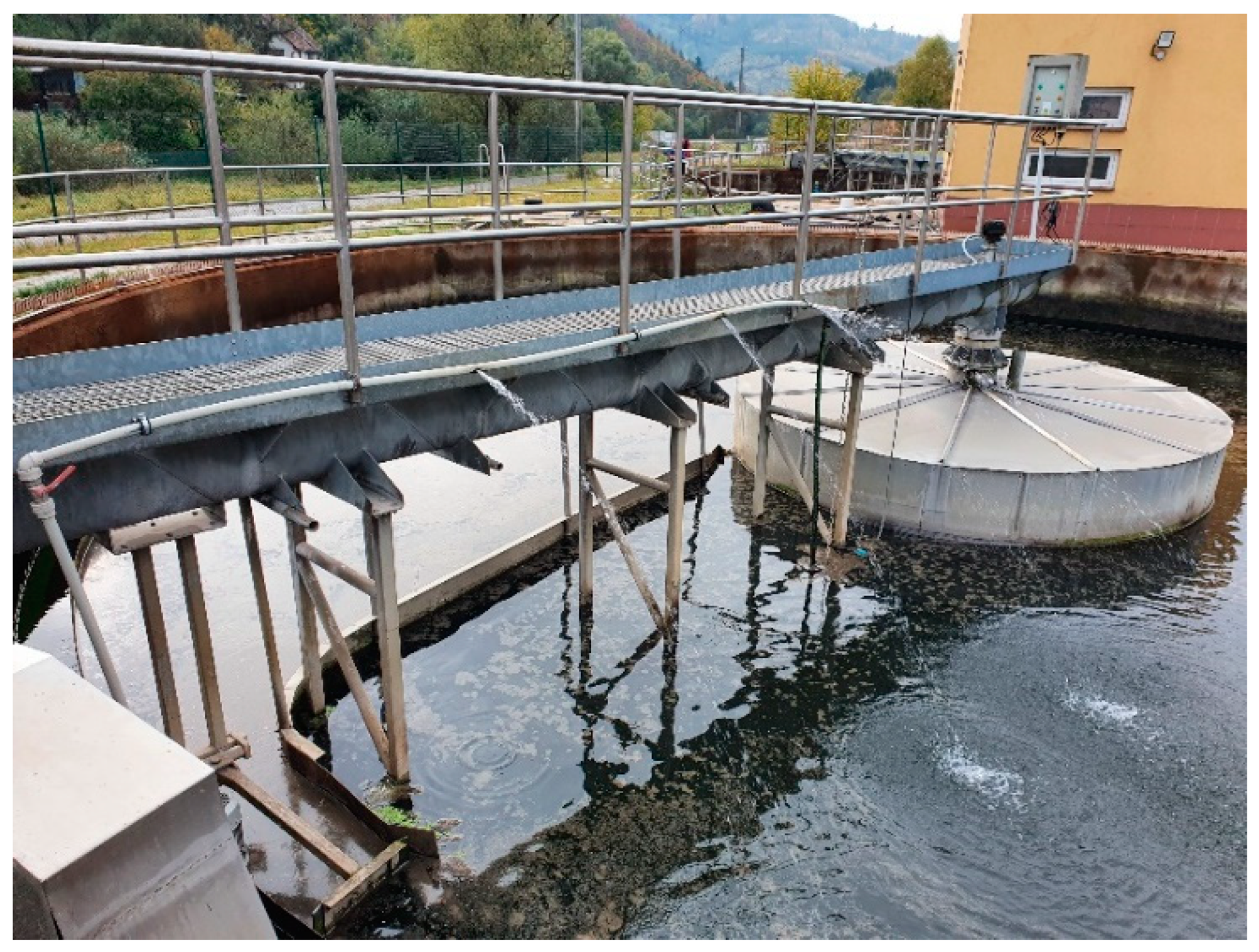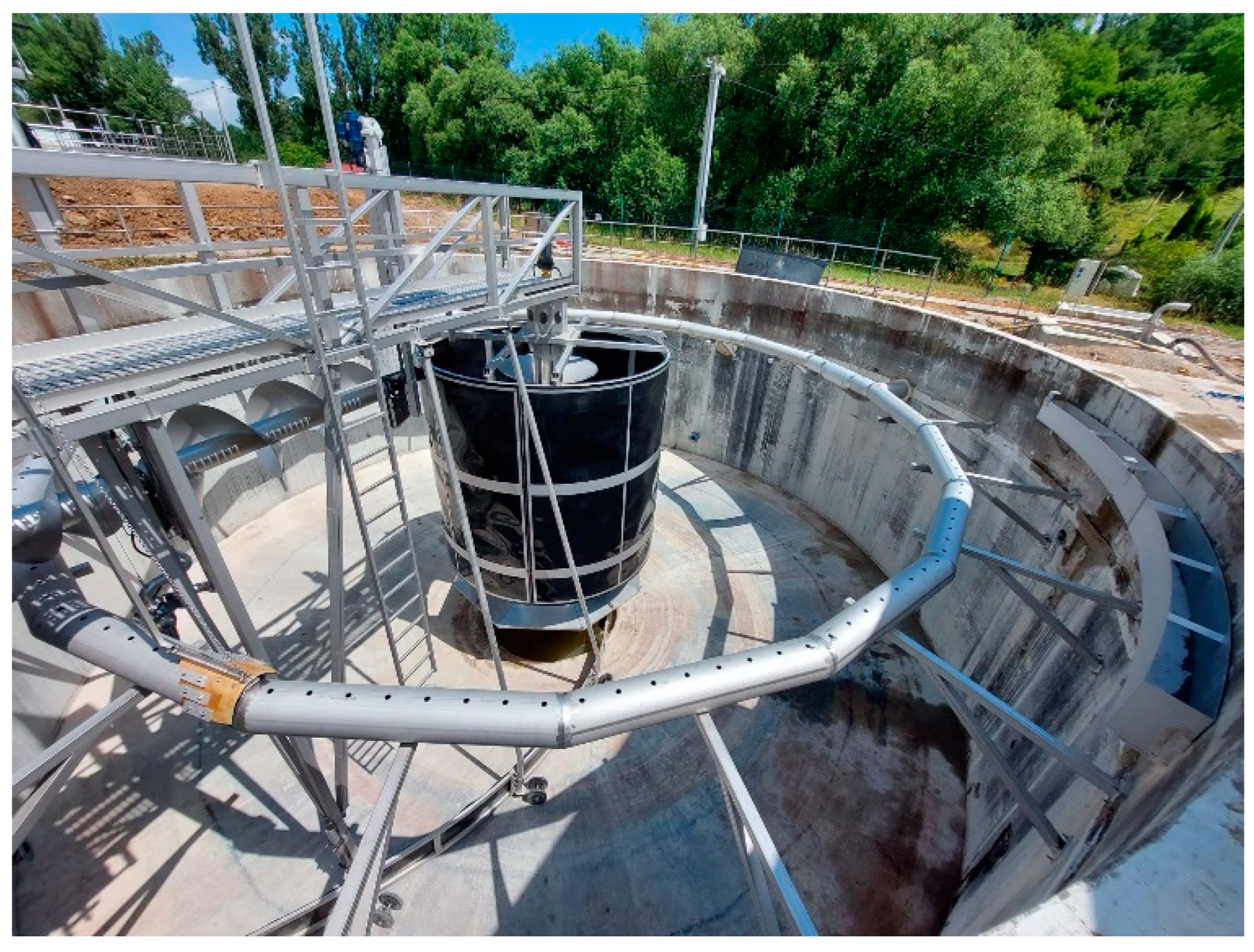The Design for the Reconstruction of Settling Tanks †
Abstract
:1. Introduction
2. Description of the Current State of the Settling Tanks before Reconstruction
3. Reconstruction Plan
3.1. Flocculation Cylinder
3.2. Travelling Bridge
3.3. Bridge Drive Mechanism
3.4. Floating Sludge Collection
4. Conclusions
Author Contributions
Funding
Institutional Review Board Statement
Informed Consent Statement
Data Availability Statement
Acknowledgments
Conflicts of Interest
References
- Bürger, R.; Diehl, S.; Farås, S.; Nopens, I. On Reliable and Unreliable Numerical Methods for the Simulation of Secondary Settling Tanks in Wastewater Treatment. Comput. Chem. Eng. 2012, 41, 93–105. [Google Scholar] [CrossRef]
- Abusam, A.; Keesman, K.J. Dynamic Modeling of Sludge Compaction and Consolidation Processes in Wastewater Secondary Settling Tanks. Water Environ. Res. 2009, 81, 51–56. [Google Scholar] [CrossRef] [PubMed]
- Bürger, R.; Diehl, S.; Nopens, I. A Consistent Modelling Methodology for Secondary Settling Tanks in Wastewater Treatment. Water Res. 2011, 45, 2247–2260. [Google Scholar] [CrossRef] [PubMed]
- Pilarski, G.; Kyncl, M.; Stegenta, S.; Piechota, G. Emission of Biogas from Sewage Sludge in Psychrophilic Conditions. Waste Biomass Valor. 2020, 11, 3579–3592. [Google Scholar] [CrossRef]
- Kubonova, L.; Janakova, I.; Malikova, P.; Drabinova, S.; Dej, M.; Smelik, R.; Skalny, P.; Heviankova, S. Evaluation of Waste Blends with Sewage Sludge as a Potential Material Input for Pyrolysis. Appl. Sci. 2021, 11, 1610. [Google Scholar] [CrossRef]
- CZECH REPUBLIC. Act No. 254/2001 Coll. on Water and Amendments to Certain Acts (Water Act). In Collection of Laws; Printing House of the Ministry of the Interior: Praha, Czech Republic, 2001; No. 98. [Google Scholar]
- CZECH REPUBLIC. Government Decree No. 401/2015 Coll. on Indicators and Values of Permissible Pollution of Surface Water and Wastewater, Details of Permits for Discharge of Wastewater into Surface Water and Sewers and on Sensitive Areas. In Collection of Laws; Printing House of the Ministry of the Interior: Praha, Czech Republic, 2015; No. 166. [Google Scholar]
- GRAU, P. Nové Řešení Výtokových Otvorů z Rozdělovacího Hrnce Flokulačních Dosazováků; AquaNova: Praha, Slovakia, 1999. [Google Scholar]
- CSN 75 0905. Water Suply and Sewerage Tanks—Testing of Water-Tightness; ČSN: Praha, Czech Republic, 2014. [Google Scholar]


Disclaimer/Publisher’s Note: The statements, opinions and data contained in all publications are solely those of the individual author(s) and contributor(s) and not of MDPI and/or the editor(s). MDPI and/or the editor(s) disclaim responsibility for any injury to people or property resulting from any ideas, methods, instructions or products referred to in the content. |
© 2023 by the authors. Licensee MDPI, Basel, Switzerland. This article is an open access article distributed under the terms and conditions of the Creative Commons Attribution (CC BY) license (https://creativecommons.org/licenses/by/4.0/).
Share and Cite
Buchta, P.; Václavík, V.; Dvorský, T. The Design for the Reconstruction of Settling Tanks. Eng. Proc. 2023, 57, 32. https://doi.org/10.3390/engproc2023057032
Buchta P, Václavík V, Dvorský T. The Design for the Reconstruction of Settling Tanks. Engineering Proceedings. 2023; 57(1):32. https://doi.org/10.3390/engproc2023057032
Chicago/Turabian StyleBuchta, Pavel, Vojtěch Václavík, and Tomaš Dvorský. 2023. "The Design for the Reconstruction of Settling Tanks" Engineering Proceedings 57, no. 1: 32. https://doi.org/10.3390/engproc2023057032
APA StyleBuchta, P., Václavík, V., & Dvorský, T. (2023). The Design for the Reconstruction of Settling Tanks. Engineering Proceedings, 57(1), 32. https://doi.org/10.3390/engproc2023057032







